Find success in writing page titles and meta descriptions for both users and search engines by following best practices and a few simple tips.
Optimizing page titles and meta descriptions is a lot like making a first impression. It’s what you’ll use to stand out amongst the crowd of results in the SERPs. Oftentimes, writers, strategists, and SEO’s tend to overthink page titles and descriptions. But if you follow best practices and test what works best within your industry and on your website, you’ll see that optimizing page titles and descriptions is fun and useful for both users and search engines.
Additionally, writing better page titles and meta descriptions can improve the overall experience users have with your website and can contribute to improvements in metrics like CTR (click-through rate). Relative to other SEO efforts like developing content and fixing technical issues, optimizing page titles and descriptions is a relatively painless (and cost-effective) way to increase visibility and gain more website traffic.
What are page titles and meta descriptions?
Page titles and meta descriptions appear in the SERPs (Search Engine Results Pages) and can either be decided by you (the webmaster, site owner, SEO, developer, etc.) or by the search engine itself. They typically tell a user the name of the page and a brief description. Here’s a more detailed explanation.
Page Titles
Page titles are the HTML elements that tell search engines the name of a particular page. They are written in between the <title> and </title> tags, and appear in several places.
- Page source code.
- The browser.
- The SERPs.
You can assign page titles in your CMS, such as WordPress, Drupal, or Squarespace since these normally have “Page Title” and “Meta Description” sections or plugins (like Yoast) that will help you define, and occasionally, optimize your page title tag to up to 70 characters.
We have built a free Meta Title Checker tool that will allow you to validate your page titles to ensure they are following best practices.
Meta Descriptions
Meta descriptions, like title tags, can be found in the source code and SERPs (but not in the browser). It defines the contents of a page and the page description or subject and is recommended not to exceed 170 characters. To quickly see your title tags and descriptions, you can use an SEO chrome extension like “Detailed SEO Extension” or “Mangools SEO Extension.”
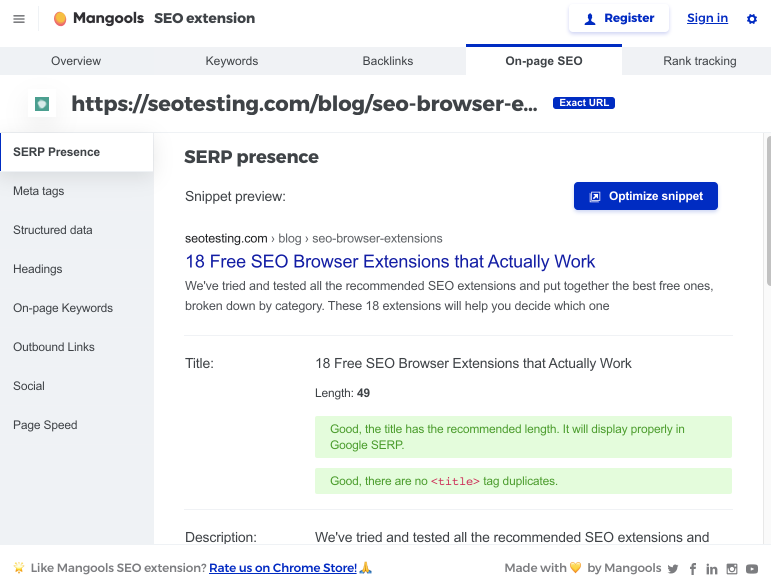
Mangools SEO Extension showing “18 Free SEO Browser Extensions that Actually Work” blog.
How do you write a title tag for SEO?
The easiest way to write a title tag is to ask yourself, “what is this page about?” and then write a compelling, short description. You should describe the page in the simplest form, adding appropriate keywords, elements, or your brand name.For example, you might want to explain that this is the home page of a local craft beer business. Here, you can see the title tag for Cigar City Brewing contains the name of the business, location, and a product differentiator in the title.
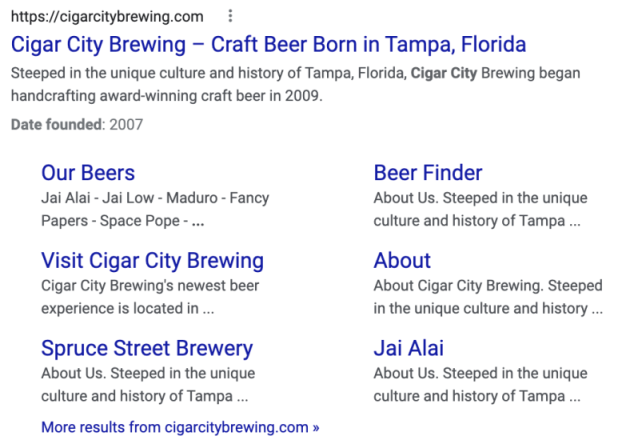
Cigar City Brewing page title and description.
Users immediately understand that when they click on the link, it will take them to the Cigar City Brewing website in Tampa, Florida.
What should an SEO Title contain?
An SEO title tag should contain elements that describe the page, either by asking a question, answering a question, adding in the page name, business or brand name, location, or another element that will indicate the subject of the page. As you start to become familiar with writing title tags and meta descriptions, you’ll notice similarities across pages and even more similarities across industries. In medical articles, for example, the page title might be the name of the post and the branded publication.
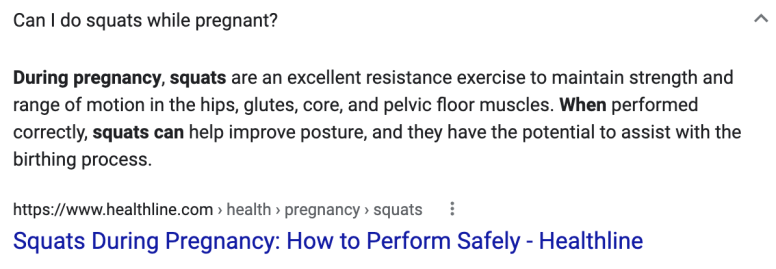
Medical Publication Title – Healthline.com ‘Squats During Pregnancy: How to Perform Safely – Healthline’
Here are some common elements you might include in an SEO title tag.
- Business name
- Page name
- Location
- Product name
- Keyword
- Branded copy
- Blog title
- Article title
- Value Proposition
- Special Characters

I always try to centre titles and descriptions on user-intent for a target query: making them unique, concise and authentic to the brand. They have to be descriptive and inspire confidence. It’s your opportunity to sell your content and stand out on SERPs, so research and monitor the competition, then take those learnings to ensure yours is more compelling. Also, because Google may not use these descriptions and instead show the first paragraph of content, make sure that paragraph is ready to do the job too! Keep on analysing, learning, tweaking and always have a close eye on your CTR.
One experiment you might want to try is adding special characters, such as [square brackets] to your titles and descriptions. These can make your titles stand out in the SERP results versus titles that don’t contain these elements. Other elements might include (parenthesis) and % percentage.
You can also try to test elements like emojis. Here’s a study by Sistrix on the effectiveness of special characters and emojis in the SERPS.
Ultimately, you’ll want to remember that a mix of clarity, brand, and psychology should guide your title tag decisions. And a fair amount of testing.
How long should a title tag be in SEO?
The general rule to follow for title tag length is between 55-65 characters, although you should test which titles work best across different page types within your industry and keyword targets.

When writing titles and descriptions, include your most important terms and compelling points as early as possible. Meta descriptions are first and foremost meant to benefit users, so make sure you pay close attention to length. Titles are also incredibly important to users of course, but you can be a LOT more flexible with title lengths — after all, even if a user sees that infamous ellipses, Google still reads the entire title and takes it all into consideration when ranking pages. Feel free to extend the length with additional information as long as it’s relevant to the page.
Regarding length, remember that quality is more important than quantity. You can choose to exceed the recommended length or keep it short-and-sweet. The more important questions are actually:
- Does this title tag accurately describe the subject of this page?
- Will users quickly understand what they are clicking on?
- Will Google (and other search engines) understand the page intent?
- Does this title contain the targeted keyword?
- Does this title tag capture the attention of my target audience?
Search Engine Journal recently published an evaluation on this very question, citing Gary Illyes’s comment that Google does not have a title tag limit. However, it’s important to note that while there may be no actual limit for the tag itself, there is a SERP limit that will only show the recommended number of characters. Further, page title length is often a subject of conversation within the SEO community. Studies indicate title tag length has little effect, others disagree.
Ultimately, you’ll want to find a balance between writing title tags that are within the SERP character limits, while also accurately describing the page you’re optimizing. There are benefits to keeping within the character count, but when it comes to whether or not these rules affect ranking or CTR is something you’ll want to test on your website.
When writing title tags don’t worry too much about title length, Google can still read the title even if it is cut off on search results pages as long as it’s a single sentence. Focus your energy instead on a title tag that describes the page, reflects the user intent, attracts user attention and is strong enough to compete against other results in SERPS.
Where does the page title tag appear?
Page title tags can appear in the results pages, web browser, and within the source code of the page. You’ll also be able to see the page title in your CMS for quick edits and optimization. However, users will typically only see the page title in two places.
- In the SERP
- Web browser

Example of a page title showing in the web browser.
For this reason, you’ll want to optimize the page titles so users are compelled to click on the result. However, if you create a page title that does not accurately describe the page content, Google will either not show your page, or create a more accurate title for you. The same is true if you don’t assign a page description. Most likely, Google will either leave the description blank or create one based on the search query and the content on the page.
What should a meta description include?
A meta description should describe or summarize the contents on a page and should anticipate query intent by addressing key points and including relevant keywords. Meta descriptions have an influence on whether or not users will click a page, so make sure you are considering who your page is for and why it’s the best result for the targeted query.
Meta Description length
Where title tags describe the page’s name, meta descriptions summarize, preview, and clarify the content on a page. Typically, meta descriptions should be between 150-170 characters. However, like page titles, it’s important to consider how users might read your meta description. Take the time to test which formats work best for your keywords and industry. Here are some reasonable tests to make during your on-page optimization for meta descriptions.
- Should you add a CTA before the title limit is spent?
- Should you add primary and secondary keywords?
- Should you summarize the page or add the most important snippet?
While this is great to keep in mind, generally you don’t have to worry too much about the description length. Think of it more as a guide for creating succinct, helpful copy about the page more than an actual “rule.”
A Note on Length Limitations
Like anything in SEO, “it depends” is a sensible answer. When working on a team, having “page title and meta description boundaries” doesn’t have to be a free-for-all just because Google says it can be any length. Limitations can also create consistency across multiple clients and pages. So while the length may not technically have limitations, there are other reasons for setting standards.
How likely is Google to use my SEO title and meta description?
There’s an excellent chance that Google won’t use your suggested title and description. According to a study published by Ahrefs,
“Google rewrites meta descriptions 62.78% of the time.” – Michal Pecánek, Ahrefs.
This is because there are millions of searches each day. It’s nearly impossible to know what the best version of your meta description copy should be. Unless, of course, you’re Google and have billions (I’m rounding) data points to consider. Does that mean the process of writing titles and descriptions is useless? Not necessarily. As Portent’s Evan Hall mentions,

I’m somewhat disheartened about how infrequently our meta descriptions are actually displayed in the SERP, and how few characters we’re likely to utilize. But I don’t think that means we should give up on writing good meta descriptions. We just need to be more clever about the process.
You’ll also want to control your website’s positioning as many times as Google will allow. While you won’t be able to predict every scenario in which your site might appear, you can still anticipate some instances.
What happens if I don’t add a page title and meta description tag?
If you do not add a title and description in your CMS, Google will create one. The process of displaying search results is automated and takes into consideration the content of the page. If Google deems your assigned descriptions as useful, accurate, and relevant, they are more likely to appear as a result. This is why you’re better off publishing your pages with an assigned title and description rather than leaving them blank. Without those elements, you let Google decide what to show if your pages are shown at all.
While we can’t manually change titles or snippets for individual sites, we’re always working to make them as relevant as possible.
Once you understand that Google’s goal is to provide the best resource for its users, you’ll make your life a lot easier.
When to change your title tag and meta description
- Intent Change
- Copy Change
- Low CTR
- Low engagement rates
- Site Changes
- Google rewrite
An obvious indication for rewriting a meta description is if you notice Google has rewritten one for you. John Mueller says there are three reasons why Google rewrites meta descriptions.
In summary, they boil down to query mismatch and poor page summarization. If you’re seeing inconsistencies in the description you’ve written compared to the one that is shown, see if you can improve the description by addressing the shown query.
How do I add a page title and meta description?
You can add your page title and meta description directly into your CMS or within your chosen SEO plugin, such as Yoast or SEOPress.
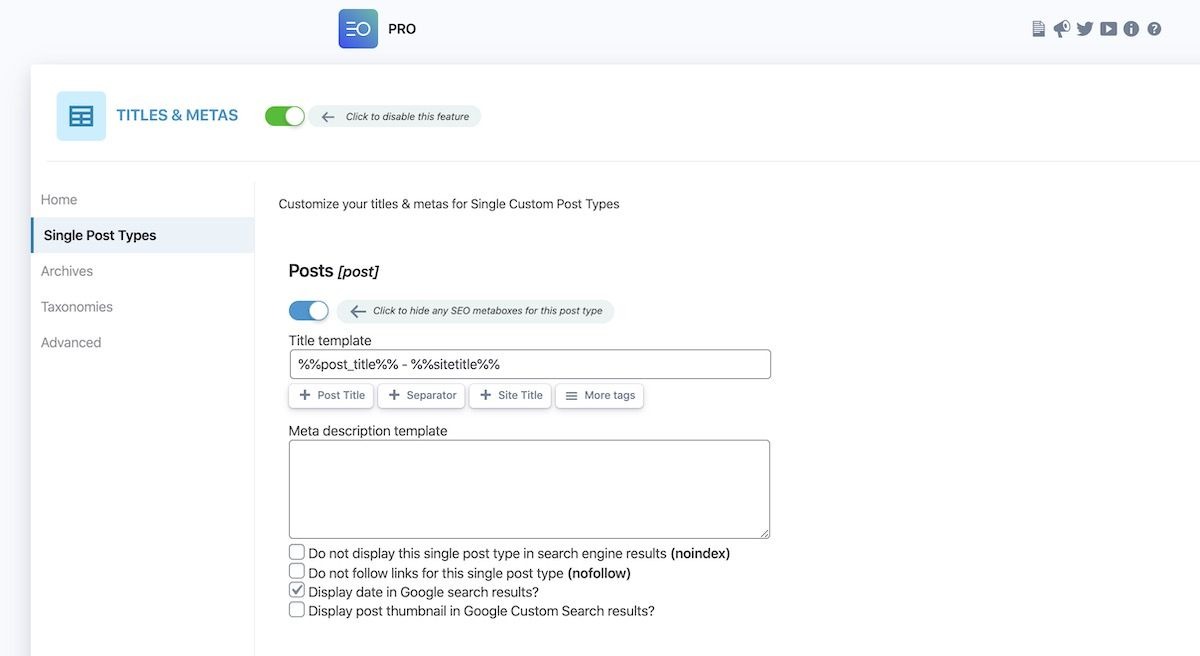
Screenshot of SEOPress
It’s easier to use an SEO tool like these since they will tell you when you’ve reached a limit or if you’re missing your target keyword within the copy. Yoast, for example, will also tell you which pages could be improved within the “all pages” view in WordPress.
While you don’t need an SEO tool to optimize your titles and descriptions, it can’t hurt to try an industry-trusted tool to see if it works for you.
Examples
Now that we’ve reviewed what titles and descriptions are, we’ll want to explore what they should look like and include. The more you explore, test, and write descriptions, the more you’ll learn what “best practices” work for your website. Please note these examples are fabricated to respect the integrity of hardworking SEOs everywhere.
What to watch for
- Too many characters. As mentioned above, too many characters can make your titles and descriptions get cut off in the SERPs. If Google is starting to rewrite your descriptions, this could be a reason why. It’s possible that the query matches the content on your page, but not your assigned descriptions.
- Wordiness. Keep your titles and descriptions clear. Wordiness can lead to a user skipping to another title that’s easier to read.
- Lack of keywords or oversaturation of keywords. While you don’t want to stuff your titles and descriptions with keywords, you’ll want to add 1-2 to attract your target user.
- Missing information. When you leave out important information from the title or description, you’ll leave the window open for competitors to create a more compelling SERP result. Do your best to anticipate why users are going to find your content the most valuable result and then make it easily understandable in your title and description.
- Query mismatch. Make sure your title and description match the content on your page and the intent of the query you are hoping to rank for. For example, you can’t create a page about “dog collars” and then title it “The Best Dog Accessories.” While it might seem relevant, your page is actually about “dog collars,” not “dog accessories.”
- Duplication. You’ll want to make sure each title and description are unique to avoid duplication and clutter. If you are seeing multiple pages with the same content, you’ll run into duplication and content cannibalization issues.
“Bad” Examples
- Washington Hospital Planet Inc.
- Buy dog collars and accessories perfect for your pooch this holiday season
- Home | Practice Law Firm, Employment Law, Business Law – Downtown Miami Law Firm
Why they’re bad
These examples show a few of the aforementioned errors. They are too long or too short, non-specific, stuffed with keywords or lacking keywords, too general, and overall an eyesore.
“Good” Examples
- Washington Hospital Planet | Care for You™ St. Louis
- Holiday Dog Collars | Shop Gifts (Free Shipping) – DogDog.com
- Rachael + Monica | NYC Housing Discrimination Attorneys
Why they’re good
These examples are quite the opposite, they have a good mix of branded copy, value positioning, and are optimized for their targeted keywords. They fit within the recommended title length and use attractive, easy-to-read formatting.

When it comes to the title tag, if you’re optimizing for local searches it can help to put the location of your business in the title tag. It’s helpful for optimizing for your region, but also for users as they are looking at a SERP. For example, if you’re a garden supply company in Louisville, KY, it shows right in the SERP in the title tag your location (for example: Urban Garden Supply in Louisville, KY). For a user searching that query in that location it can help make it pop. Another thing I always try and do is include a call-to-action in the meta description that is applicable to the page the user would land on. So whether it’s “read more” or “get a demo” in can help encourage users to click-through. Also, don’t be afraid to include action verbs in your title like “Apply,” “Discover,” “Download,” etc. I’ve seen some nice increases in click-through-rates when words like that are included in the title tags.
Recent Studies
Buzzumo recently published a study of over 100 million headlines to see what created the most engagement on social media. In reviewing these headlines, you’ll be able to see what language increases engagement (clicks) and adopt them into your SEO title tag tests. Keep in mind that “good” and “bad” are relative terms. Continue to study and test your titles to see what works for you.
How to test your titles and descriptions
An easy way to make sure your page titles and descriptions are working is to test them.
- First, review your analytics to see which pages have duplicated titles and descriptions or have poor results, such as low CTR.
- Run an audit with your technical SEO tool, like Sitebulb, to see all your titles and descriptions at once.
- See which titles and descriptions you’d like to make changes on. Note which URLs you’ll use as your control group and which you’ll use as your test group.
- Plan and upload your changes. You can use a Snippet Preview tool and the “Title Case” function in Google Docs to easily format and preview your changes.
- Track results manually or with a tool like SEOtesting.com to view and analyze the results of your changes.
- Roll out your changes across the remainder of your site and continue to test, or start a new test.
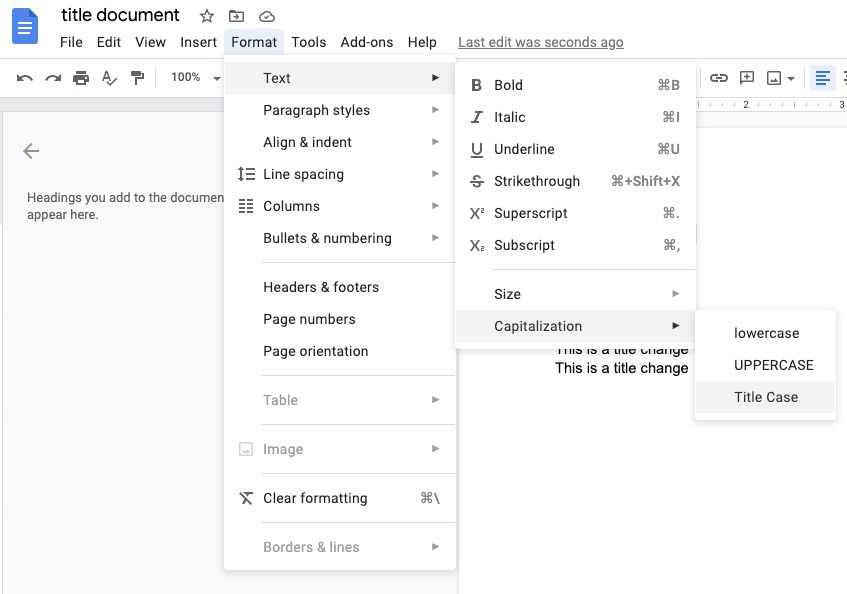
Title case setting in Google Docs
In summary, here’s what to keep in mind when it comes to title tags and meta descriptions:
- Be clear about the subject of your page.
- Craft a compelling, yet accurate page title and meta description.
- Use 50-65 characters for page titles, and 140-170 characters for meta descriptions.
- Test which elements work across similar pages within your given industry.
- Avoid using the same keyword unnaturally (keyword stuffing).
- Consider the search engine. Optimize for where you want to rank.
- Be unique. Each title and description should only appear once on your site.
- Remember important elements like your brand, location, and value propositions.
- Write for both users and search engines, not either-or.

